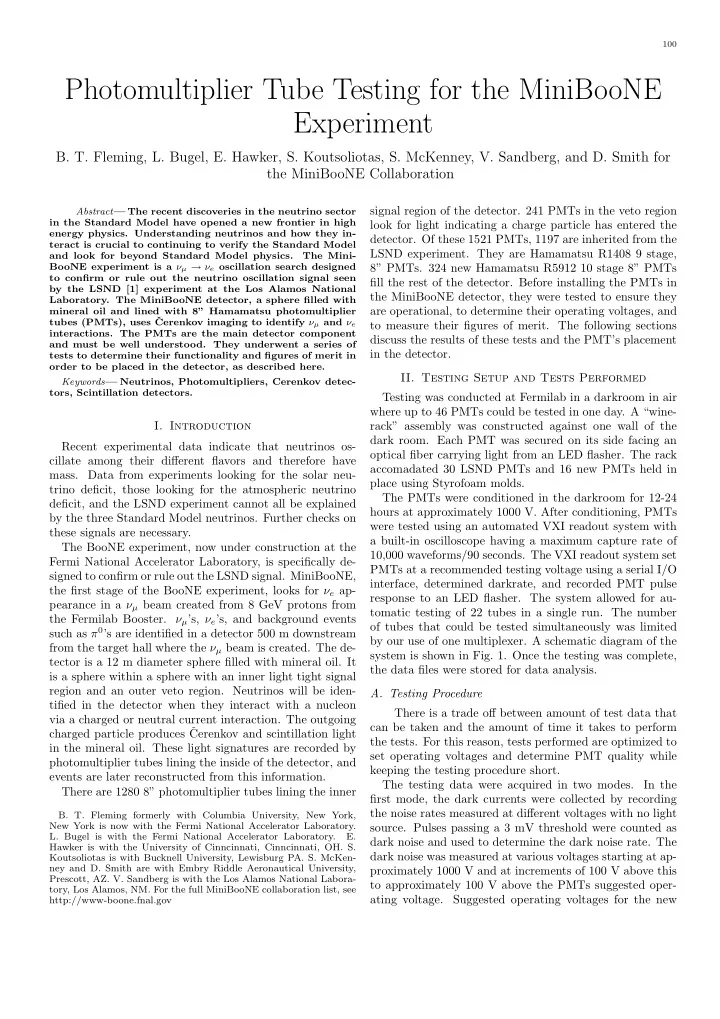

100 Photomultiplier Tube Testing for the MiniBooNE Experiment B. T. Fleming, L. Bugel, E. Hawker, S. Koutsoliotas, S. McKenney, V. Sandberg, and D. Smith for the MiniBooNE Collaboration signal region of the detector. 241 PMTs in the veto region Abstract — The recent discoveries in the neutrino sector in the Standard Model have opened a new frontier in high look for light indicating a charge particle has entered the energy physics. Understanding neutrinos and how they in- detector. Of these 1521 PMTs, 1197 are inherited from the teract is crucial to continuing to verify the Standard Model LSND experiment. They are Hamamatsu R1408 9 stage, and look for beyond Standard Model physics. The Mini- BooNE experiment is a ν µ → ν e oscillation search designed 8” PMTs. 324 new Hamamatsu R5912 10 stage 8” PMTs to confirm or rule out the neutrino oscillation signal seen fill the rest of the detector. Before installing the PMTs in by the LSND [1] experiment at the Los Alamos National the MiniBooNE detector, they were tested to ensure they Laboratory. The MiniBooNE detector, a sphere filled with are operational, to determine their operating voltages, and mineral oil and lined with 8” Hamamatsu photomultiplier tubes (PMTs), uses ˇ Cerenkov imaging to identify ν µ and ν e to measure their figures of merit. The following sections interactions. The PMTs are the main detector component discuss the results of these tests and the PMT’s placement and must be well understood. They underwent a series of in the detector. tests to determine their functionality and figures of merit in order to be placed in the detector, as described here. II. Testing Setup and Tests Performed Keywords — Neutrinos, Photomultipliers, Cerenkov detec- tors, Scintillation detectors. Testing was conducted at Fermilab in a darkroom in air where up to 46 PMTs could be tested in one day. A “wine- rack” assembly was constructed against one wall of the I. Introduction dark room. Each PMT was secured on its side facing an Recent experimental data indicate that neutrinos os- optical fiber carrying light from an LED flasher. The rack cillate among their different flavors and therefore have accomadated 30 LSND PMTs and 16 new PMTs held in mass. Data from experiments looking for the solar neu- place using Styrofoam molds. trino deficit, those looking for the atmospheric neutrino The PMTs were conditioned in the darkroom for 12-24 deficit, and the LSND experiment cannot all be explained hours at approximately 1000 V. After conditioning, PMTs by the three Standard Model neutrinos. Further checks on were tested using an automated VXI readout system with these signals are necessary. a built-in oscilloscope having a maximum capture rate of The BooNE experiment, now under construction at the 10,000 waveforms/90 seconds. The VXI readout system set Fermi National Accelerator Laboratory, is specifically de- PMTs at a recommended testing voltage using a serial I/O signed to confirm or rule out the LSND signal. MiniBooNE, interface, determined darkrate, and recorded PMT pulse the first stage of the BooNE experiment, looks for ν e ap- response to an LED flasher. The system allowed for au- pearance in a ν µ beam created from 8 GeV protons from tomatic testing of 22 tubes in a single run. The number the Fermilab Booster. ν µ ’s, ν e ’s, and background events of tubes that could be tested simultaneously was limited such as π 0 ’s are identified in a detector 500 m downstream by our use of one multiplexer. A schematic diagram of the from the target hall where the ν µ beam is created. The de- system is shown in Fig. 1. Once the testing was complete, tector is a 12 m diameter sphere filled with mineral oil. It the data files were stored for data analysis. is a sphere within a sphere with an inner light tight signal region and an outer veto region. Neutrinos will be iden- A. Testing Procedure tified in the detector when they interact with a nucleon There is a trade off between amount of test data that via a charged or neutral current interaction. The outgoing can be taken and the amount of time it takes to perform charged particle produces ˇ Cerenkov and scintillation light the tests. For this reason, tests performed are optimized to in the mineral oil. These light signatures are recorded by set operating voltages and determine PMT quality while photomultiplier tubes lining the inside of the detector, and keeping the testing procedure short. events are later reconstructed from this information. The testing data were acquired in two modes. In the There are 1280 8” photomultiplier tubes lining the inner first mode, the dark currents were collected by recording the noise rates measured at different voltages with no light B. T. Fleming formerly with Columbia University, New York, New York is now with the Fermi National Accelerator Laboratory. source. Pulses passing a 3 mV threshold were counted as L. Bugel is with the Fermi National Accelerator Laboratory. E. dark noise and used to determine the dark noise rate. The Hawker is with the University of Cinncinnati, Cinncinnati, OH. S. dark noise was measured at various voltages starting at ap- Koutsoliotas is with Bucknell University, Lewisburg PA. S. McKen- ney and D. Smith are with Embry Riddle Aeronautical University, proximately 1000 V and at increments of 100 V above this Prescott, AZ. V. Sandberg is with the Los Alamos National Labora- to approximately 100 V above the PMTs suggested oper- tory, Los Alamos, NM. For the full MiniBooNE collaboration list, see ating voltage. Suggested operating voltages for the new http://www-boone.fnal.gov
Recommend
More recommend